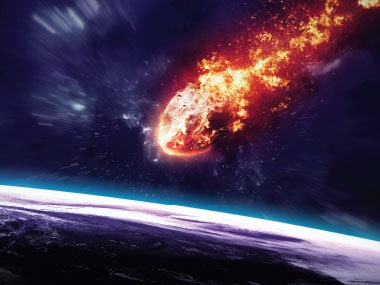On December 18, 2018, around noon local time, a huge fireball was reported at a remote spot over the Kamchatka peninsula, in the Russian far east. Since the location is very remote, there were no visual reports of the explosion and after, but monitoring stations set up worldwide to detect nuclear explosions recorded the low-frequency sound waves caused by this cataclysmic event. The event was also captured by cameras on a Japanese weather satellite. [caption id=“attachment_6351871” align=“alignleft” width=“380”]  Representational image. Shutterstock[/caption] The explosion was caused by the burning of a meteor 10 metres in diameter, weighing more than 1,400 tonnes and moving at more than 100,000 kph which burnt itself at a height of around 25 km in the atmosphere. The energy released by the event is estimated to be equivalent to around 170 kilotons of TNT. To get a perspective on this number, the total energy released in the atomic bombing of Hiroshima was about 10 times smaller. Meteors hitting the earth are a common phenomenon—remember those wishes made when one spotted a shooting star? A shooting star is a meteor, a rock from space which burns itself in the earth’s atmosphere. They are relatively benign objects that bombard our earth from outer space, classed as meteoroids, which burn in the atmosphere, releasing energy in the form of shockwaves, light and heat. Meteoroids and their much larger cousins, asteroids, orbit the sun. They are remnants from the material that formed our planets. If a small asteroid or a large meteoroid survives its path through the atmosphere and impacts the ground, it is called a meteorite. Asteroids can vary in size from about a metre across to Ceres, the largest known asteroid which has a diameter of around 1,000 km. Most of them are made of rock but can also contain metals like iron and nickel as well as water and various gases. In fact, the earliest iron used by humans on earth was almost certainly meteoritic in origin. All of this space debris orbits around the Sun. A majority of the asteroids reside in the asteroid belt between Mars and Jupiter. However, some asteroids, prosaically called Near-Earth objects, have orbits which are close to the earth’s orbit, some of them even crossing it. And sometimes they do land on earth, with devastating consequences. It is estimated that an asteroid the size of a car hits the earth once a year on average. However, an object this size typically burns itself in the atmosphere and disintegrates. Once every 5,000 years or so, a much larger asteroid, say the size of a football field, would hit the earth and leave its mark. The well-known crater in Arizona was caused by such an impact some 50,000 years ago. Closer home, Lonar Lake in Maharashtra was formed from a crater caused by an asteroid hit. And once every few million years, we have a monster of an impact—an impact which can change whole ecosystems and bring about profound changes in the environment. Some 65 million years ago, an object with a diameter around 15 km crashed into what is today the Yucatán Peninsula in Mexico. The impact of this object was, to put it mildly, huge. It dug a hole 100 km wide and 30 km deep. The energy released in this impact is estimated to be around a trillion times of what devastated Hiroshima. But numbers don’t quite give an idea of the cataclysm caused by this single event: 100-metre high tsunamis, clouds of dust and ash being thrown high into the atmosphere and shockwaves and earthquakes of such devastating magnitude that our own Richter scale would be too miniscule to quantify them. The dust and ash would have heated up on re-entering the atmosphere causing huge infernos and destroying most forests. The change in the atmosphere as well as on the ground and in the oceans caused a mass extinction of almost 75 per cent of existing life, including most of the dinosaurs, thus allowing the remaining mammalian species to propagate. Fireballs like the one which was recorded over Kamchatka in December, though rare, have been known to occur. In fact, in 2013, an asteroid around 20 metres in size had crashed over the Russian city of Chelyabinsk. The high velocity of the Chelyabinsk meteor made it brighter than the Sun; the shockwaves of the explosion caused windows to shatter and injured many. The video of the event went viral soon after it was released. A much bigger event had taken place in 1908 over Siberia. The Tunguska event, thought to be the largest such event in recorded history, caused shockwaves that destroyed millions of trees in the Siberian taiga. An impact by a large asteroid causing a global catastrophe might be extremely rare. However, that is no cause for complacency. NASA has an office of Planetary Defense Coordination which looks for objects bigger than 30 metres close to earth. ‘Close’ here is anything closer than about 8 million km. What do we do if we detect such an object flying coming towards us? Not much really, apart from trying to change its path or even obliterate it with thermonuclear bombs. This may or may not work since it has only been tried out in computer simulations. Events like Tunguska, Chelyabinsk or even the most recent one over Kamchatka remind us that, despite our enormous technological capabilities, our existence on earth is precariously dependent on the unknowns of the universe. Dr Shobhit Mahajan teaches physics at the University of Delhi
Deflecting an incoming asteroid in space from its path or ‘killing’ it with a nuke exists only in the realm of computer simulations
Advertisement
End of Article


)

)
)
)
)
)
)
)
)



